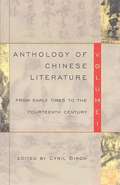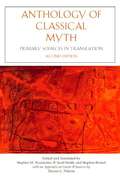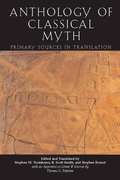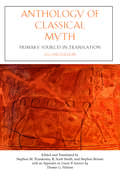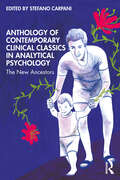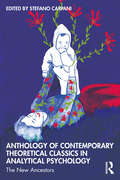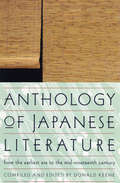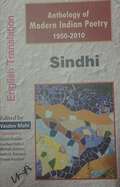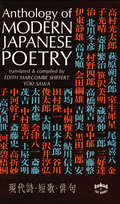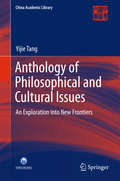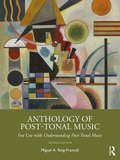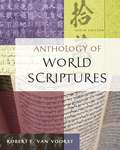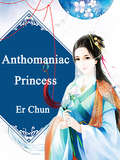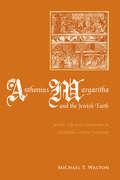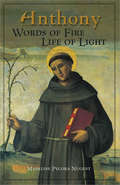- Table View
- List View
Anthology of Chinese Literature: From Early Times to the Fourteenth Century (Volume I)
by Cyril BirchInternationally renowned Chinese literature scholar Cyril Birch was the first to assemble the finest translations of these seminal pieces in his now classic and still definitive introductory anthologies. The selections in this first volume span a two-thousand-year period: from the Chou Dynasty (1122–221 B.C.) to the Y’an Dynasty (A.D. 1280–1367), from the ancient Songs to the dramas of the fourteenth century, every major genre of Chinese literature is represented by a crucial work. Highlights include, in addition to the great poems of the T’ang, outstanding examples of Han poetry, Six Dynasties satire, T’ang-sung prose essays and fiction, and the form of lyric known as “tz’u.”
Anthology of Classical Myth
by Stephen Brunet R. Scott Smith Stephen M. Trzaskoma Thomas G. PalaimaThis is a collection of translations of ancient Greek and Roman sources that we have found suitable for teaching classical mythology at the undergraduate level. In that sense, the title is misleading, but Anthology of Stuff That Is Connected in One Way or Another with Mythology in the Ancient World seemed a tad unwieldy to us.
Anthology of Classical Myth: Primary Sources in Translation
by Stephen Brunet R. Scott Smith Stephen TrzaskomaTrzaskoma, R. Scott Smith, and Stephen Brunet (all classics, U. of New Hampshire) have assembled and newly translated ancient Greek and Roman texts relating in one way or another to mythology in the ancient world. They selected those that they have found useful for teaching classical mythology at the undergraduate level. Mostly excerpts, the passages are arranged alphabetically by author. Supporting the anthology are maps; genealogical charts; timelines; appendices on Linear B sources, inscriptions, and papyri; notes on texts and translations, explanations of names and transliteration, and a combination index and glossary. Annotation ©2004 Book News, Inc., Portland, OR (booknews.com)
Anthology of Classical Myth: Primary Sources in Translation
by Stephen Brunet R. Scott Smith Stephen M. TrzaskomaThis new edition of Anthology of Classical Myth offers selections from key Near Eastern texts—the Babylonian Epic of Gilgamesh, Epic of Creation (Enuma Elish), and Atrahasis; the Hittite Song of Emergence; and the flood story from the book of Genesis—thereby enabling students to explore the many similarities between ancient Greek and Mesopotamian mythology and enhancing its reputation as the best and most complete collection of its kind.
Anthology of Contemporary Clinical Classics in Analytical Psychology: The New Ancestors
by Stefano CarpaniThis anthology of contemporary classics in analytical psychology bring together academic, scholarly and clinical writings by contributors who constitute the "post-Jungian" generation. Carpani brings together important contributions from the Jungian world to establish the "new ancestors" in this field, in order to serve future generations of Jungian analysts, scholars, historians and students. This generation of clinicians and scholars has shaped the contemporary Jungian landscape and their work continues to inspire discussions on key topics including archetypes, race, gender, trauma and complexes. Each contributor has selected a piece of their work which they feel best represents their research and clinical interests, each aiding the expansion of current discussions on Jung and contemporary analytical psychology studies. Spanning two volumes, which are also accessible as standalone books, this essential collection will be of interest to Jungian analysts and therapists, as well as academics and students of Jungian and post-Jungian studies.
Anthology of Contemporary Theoretical Classics in Analytical Psychology: The New Ancestors
by Stefano CarpaniThis anthology of contemporary classics in analytical psychology bring together academic, scholarly and clinical writings by contributors who constitute the "post-Jungian" generation. Carpani brings together important contributions from the Jungian world to establish the "new ancestors" in this field, in order to serve future generations of Jungian analysts, scholars, historians and students. This generation of clinicians and scholars has shaped the contemporary Jungian landscape, and their work continues to inspire discussions on key topics including archetypes, race, gender, trauma and complexes. Each contributor has selected a piece of their work which they feel best represents their research and clinical interests, each aiding the expansion of current discussions on Jung and contemporary analytical psychology studies. Spanning two volumes, which are also accessible as standalone books, this essential collection will be of interest to Jungian analysts and therapists, as well as to academics and students of Jungian and post-Jungian studies.
Anthology of Hindi Short Stories
by Jai Ratan Bhisham SahniAnthology of Hindi Short Stories: English translation by Jai Ratan of Hindi Kahani Sangbrah, compiled by Bhisham Sahni.
Anthology of Japanese Literature
by Donald KeeneThe sweep of Japanese literature in its infinite variety and unusual beauty-from earliest times to the mid-nineteenth century-is the focus of this impressive volume. Every genre and style of Japanese literature, from the somber beauty of Noh plays to the eroticism of seventeenth-century novels is included. Other offerings include poetry and haiku, folktales and legends. The translations have been chosen not only for their accuracy but also for their readability as English prose and poetry.Donald Keene's informative Introduction traces links between the various works, some of which may be foreign to Western readers. The result is a thorough and fascinating insight into the literature and culture of classical Japan.
Anthology of Japanese Literature, From the Earliest Era to the Mid-Nineteenth Century
by Donald KeeneA sweep of Japanese literature in all its great variety and unusual beauty, every genre and style, from poems to plays to novels.
Anthology of Japanese Literature: From the Earliest Era to the Mid-Nineteenth Century (Unesco Collection Of Representative Works)
by Donald KeeneThe sweep of Japanese literature in all its great variety was made available to Western readers for the first time in this anthology. Every genre and style, from the celebrated No plays to the poetry and novels of the seventeenth century, find a place in this book. An introduction by Donald Keene places the selections in their proper historical context, allowing the readers to enjoy the book both as literature and as a guide to the cultural history of Japan. Selections include "Man’yoshu” or "Collection of Ten Thousand Leaves” from the ancient period; "Kokinshu” or "Collection of Ancient and Modern Poetry,” "The Tosa Diary” of Ki No Tsurayuki, "Yugao” from "Tales of Genji” of Murasaki Shikibu, and "The Pillow Book” of Sei Shonagon from the Heian Period; "The Tale of the Heike” from the Kamakura Period; Plan of the No Stage, "Birds of Sorrow” of Seami Motokiyo, and "Three Poets at Minase” from the Muromachi Period; and Sections from Basho, including "The Narrow Road of Oku,” "The Love Suicides at Sonezaki” by Chikamatsu Monzaemon, and Waka and haiku of the Tokugawa Period.
Anthology of Modern American Poetry
by Cary NelsonAnthology of Modern American Poetry contains more than 750 poems by 161 American poets, including many who have not been anthologized before.
Anthology of Modern Indian Poetry (1950-2010)
by Vasdev MohiA positive element evident in today’s poetry is creative use of language. There are many examples of new combinations, new constructions, touching, picturesque expressions, and unique examples of personification which have not found place in the earlier Sindhi poetry. The language used by poets in their poetry is such that it has become a part of its nervous system. Due to this factor creation appears to be breathing. It does not mean that in early poetry the creative language was not used but during that period the language was used only as a vehicle of expression, like a garment to create an effect and make it attractive. In contrast to this, today the language is used in such a manner that even slight pinch on a cell would damage the entire nervous system of the poetry. The language, being in itself a potent vehicle of manifestation, has now discarded the figures of speech, considered as ‘ornaments’ of the language earlier. Today’s creation does not depend on adornments. Today words of poetry are not signifiers, but are signified; they do not ‘state’, but ‘convey’ what is to be said. During progressive period the emphasis was on ‘what’ is said and in the post modernist poetry accent is on ‘how’ it is said. … Sindhi poetry is a continuous creative process in which with the passage of time much is cast off, much is brought in, and this goes on unabated.
Anthology of Modern Japanese Poetry
by Yuki Sawa Edith Marcombe ShiffertThe state of Japanese poetry in the twentieth century, its high quality and individuality is clearly shown in this book. The introduction gives a brief,lucid history of poetry in Japan, with the emphasis on modern poetry. The body of the book is taken up with the translation of the work of forty-nine widely acclaimed poets: free-verse poets, tanka poets, and haiku poets. At the back are notes giving illuminating biographical and literary information about each poet.The excellence of the translations and the lucidity of the introduction and notes make the book a treasure for poetry lovers everywhere .
Anthology of Philosophical and Cultural Issues: An exploration into new frontiers (China Academic Library)
by Yijie TangThis book argues that a general understanding of traditional Chinese philosophy can be achieved by a concise elaboration of its truth, goodness and beauty; that goodness and beauty in Chinese philosophy, combined with the integration of man and heaven, knowledge and practice, scenery and feeling, reflect a pursuit of an ideal goal in traditional Chinese philosophy characterized by the thought mode uniting man and nature. This book also discusses the anti-traditionalism of the May Fourth Movement, explaining that the true value of "sagacity theory" in traditional Chinese philosophy, especially in Neo-Confucianism in the Song and Ming dynasties, lies in its insights into universal life. In addition, existing ideas, issues, terminologies, concepts, and logic of Chinese philosophical thought were actually shaped by Western philosophy. It is necessary to be alienated from traditional status for the creation of a viable "Chinese philosophy. " "Modern Chinese philosophy" in the 1930s and 1940s was comprised of scholarly work that characteristically continued rather than followed the traditional discourse of Chinese philosophy. That is to say, in the process of studying and adapting Western philosophy, Chinese philosophers transformed Chinese philosophy from traditional to modern. In the end of the book, the author puts forward the idea of a "New Axial Age. " He emphasizes that the rejuvenation of Chinese culture we endeavor to pursue has to be deeply rooted in our mainstream culture with universal values incorporating cultures of other nations, especially the cultural essence of the West.
Anthology of Post-Tonal Music: For Use with Understanding Post-Tonal Music
by Miguel A. Roig-FrancolíThis anthology of over 40 scores and excerpts represents a wide range of music from across the twentieth century and into the twenty-first century, from pieces by Debussy, Stravinsky, and Bartok to works by Arvo Pärt, Thomas Adès, and Kaija Saariaho. Showcasing the vast range of compositional styles encompassed in the post-tonal era, this volume offers a convenient compendium including hard-to-find scores. Designed for use with Understanding Post-Tonal Music by Miguel A. Roig-Francolí, which includes extensive analyses of the scores provided here, this anthology can also stand alone for study and analysis in other courses on the history and analysis of post-tonal music.
Anthology of World Religions: Sacred Texts and Contemporary Perspectives
by Lewis VaughnAnthology of World Religions explores the world's religious traditions by combining substantial overviews of their history, beliefs, and practices with selections from their texts and scriptures and commentary by contemporary practitioners and scholars. It covers each major religion's history,teachings, founder, leaders, practices, and the factors that are now challenging and changing it--secularism, modernism, pluralism, science, the status of women, and sectarian or factional conflicts. The introductory chapter reviews various approaches to the study of religion, defines religiousterms and concepts, discusses theories of religion, and distinguishes between the insider and outsider perspectives on religious traditions.
Anthology of World Scriptures (6th edition)
by Robert E. Van VoorstAll major living faiths express their teachings in the form of writing. Van Voorst (Western Theological Seminary) surveys twelve of the most prominent, focusing on their texts and what they say about the nature of life, what came before and what comes after, the relationship with the divine, and how one should live with those in and out of the faith. He covers Hinduism, Buddhism, Jainism, Sikhism, Confucianism, Taoism, Shinto, Zoroastrianism, Judaism, Christianity, Islam, and newer movements such as Baha'i, Christian Science, The Church of Jesus Christ of Latter-Day Saints, and the Unification Church. Van Voorst gives contexts to each selection of scripture through the faiths' history, teaching, organization, ethics, and ritual, provides material from supporting texts, and includes a glossary and a review of the scriptures in film. Annotation ©2004 Book News, Inc. , Portland, OR (booknews. com)
Anthomaniac Princess: Volume 1 (Volume 1 #1)
by Er Chun"Seventh Prince, have you seen how well I've painted your smoky makeup today?" "Hong Liang, Miss Qiao has a sharp eye. She is to be escorted back to the mansion and is to be accompanied by Su Erzhong to treat Miss Qiao." "Hey, Seventh Prince, don't go yet. There's nothing wrong with my eyes, and I haven't slept for the whole night. I've written a few poems for you, you can listen to them." Seventh Prince was the heavens, Seventh Prince was the earth, and Seventh Prince was the radish and vegetables. Small cool is a flower, small cool is a treasure, small cool is that day fairy. "Ah — the flower and the radish with the fairy, a natural pair!" Just as she finished speaking, the purple-clothed servant girl stood beside the pink-clothed lady with big strides and also held up the cloth in her hand. She recited: "You are the number one marshal in the world, I am the prettiest in the world, you and I love each other and have a fat child to kiss!"
Anthomaniac Princess: Volume 2 (Volume 2 #2)
by Er Chun"Seventh Prince, have you seen how well I've painted your smoky makeup today?" "Hong Liang, Miss Qiao has a sharp eye. She is to be escorted back to the mansion and is to be accompanied by Su Erzhong to treat Miss Qiao." "Hey, Seventh Prince, don't go yet. There's nothing wrong with my eyes, and I haven't slept for the whole night. I've written a few poems for you, you can listen to them." Seventh Prince was the heavens, Seventh Prince was the earth, and Seventh Prince was the radish and vegetables. Small cool is a flower, small cool is a treasure, small cool is that day fairy. "Ah — the flower and the radish with the fairy, a natural pair!" Just as she finished speaking, the purple-clothed servant girl stood beside the pink-clothed lady with big strides and also held up the cloth in her hand. She recited: "You are the number one marshal in the world, I am the prettiest in the world, you and I love each other and have a fat child to kiss!"
Anthomaniac Princess: Volume 3 (Volume 3 #3)
by Er Chun"Seventh Prince, have you seen how well I've painted your smoky makeup today?" "Hong Liang, Miss Qiao has a sharp eye. She is to be escorted back to the mansion and is to be accompanied by Su Erzhong to treat Miss Qiao." "Hey, Seventh Prince, don't go yet. There's nothing wrong with my eyes, and I haven't slept for the whole night. I've written a few poems for you, you can listen to them." Seventh Prince was the heavens, Seventh Prince was the earth, and Seventh Prince was the radish and vegetables. Small cool is a flower, small cool is a treasure, small cool is that day fairy. "Ah — the flower and the radish with the fairy, a natural pair!" Just as she finished speaking, the purple-clothed servant girl stood beside the pink-clothed lady with big strides and also held up the cloth in her hand. She recited: "You are the number one marshal in the world, I am the prettiest in the world, you and I love each other and have a fat child to kiss!"
Anthonius Margaritha and the Jewish Faith: Jewish Life and Conversion in Sixteenth-Century Germany
by Michael T. WaltonA biography of Anthonius Margaritha, convert to Christianity and reporter on Jewish life and religious practices.
Anthony
by Madeline Pecora NugentThrough detailed research and the actual words of St. Anthony, the author takes the reader on an imaginative journey into the lives and spiritual struggles of people who lived with, confided in, heeded, or defied this holy Franciscan. In meeting those whose lives Anthony touched, the reader will come to love this saint.
